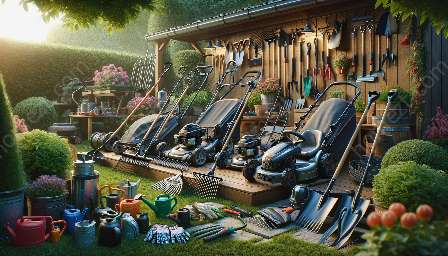Are you looking to transform your lawn into a lush, green paradise? Whether you're a gardening enthusiast or someone seeking domestic services, maintaining a beautiful lawn requires time and effort. In this comprehensive guide, we'll explore everything you need to know about lawn care, including mowing, watering, fertilizing, and weed control.
Mowing
Mowing is a fundamental aspect of lawn care and plays a crucial role in maintaining a healthy, vibrant lawn. Proper mowing height, frequency, and technique can significantly impact the overall health and appearance of your lawn. By understanding the best practices for mowing, you can keep your lawn looking its best throughout the year.
Mowing Height
Most grass species have an ideal mowing height that promotes healthy growth and discourages weed invasion. For cool-season grasses such as Kentucky bluegrass and fescue, a mowing height of 2.5-3.5 inches is recommended. Warm-season grasses like Bermuda grass and zoysia grass thrive at lower mowing heights of 0.5-2 inches. By adhering to these guidelines, you can ensure that your lawn remains healthy and resilient.
Mowing Frequency
The frequency of mowing is determined by the growth rate of your grass and the season. During the peak growing season, it's often necessary to mow once a week to prevent your lawn from becoming overgrown. However, in periods of slow growth, you may only need to mow every two to three weeks. It's essential to avoid cutting more than one-third of the grass blade in a single mowing session to prevent stress and damage to the lawn.
Mowing Technique
Using a sharp mower blade and following a consistent mowing pattern can lead to cleaner cuts and healthier grass. It's important to vary the mowing direction each time to prevent the grass from developing a grain pattern. Additionally, leaving grass clippings on the lawn can provide nutrients and moisture to the soil, promoting overall lawn health.
Watering
Proper watering is essential for maintaining a thriving lawn. However, it's important to strike a balance, as both overwatering and underwatering can have negative effects on your lawn's health.
Watering Frequency
The frequency of watering should be determined by the weather conditions and soil type. While it's essential to provide enough water to promote deep root growth, it's equally important to avoid excessive watering that can lead to waterlogged soil and disease. A general guideline is to water your lawn 1-1.5 inches per week, either through rainfall or irrigation, for optimal growth.
Timing
The best time to water your lawn is in the early morning, as this allows the grass to dry before evening and reduces the risk of fungal diseases. Watering during the heat of the day can result in excessive evaporation, while watering in the evening can leave the grass wet for an extended period, promoting disease development.
Fertilizing
Fertilizing provides essential nutrients to your lawn, promoting healthy growth and vibrant color. By understanding the different types of fertilizers and the appropriate application techniques, you can enhance the overall health and appearance of your lawn.
Types of Fertilizers
There are two primary types of lawn fertilizers: granular and liquid. Granular fertilizers are applied with a spreader and release nutrients slowly over time. Liquid fertilizers are quickly absorbed by the grass and provide a fast-acting nutrient boost. Both types have their benefits and should be chosen based on your lawn's specific needs and your desired application method.
Application Techniques
Proper application of fertilizer involves calculating the correct amount and distributing it evenly across your lawn. It's important to follow the manufacturer's recommendations regarding application rates and timing to avoid overapplication, which can lead to lawn burning. As a general rule, it's best to fertilize in the early spring and late fall to promote healthy root development and winter hardiness.
Weed Control
Weeds can detract from the beauty of your lawn and compete with grass for valuable nutrients and resources. Implementing effective weed control strategies is essential for maintaining a healthy, weed-free lawn.
Preventative Measures
Preventing the establishment of weeds is often more effective than tackling them once they've taken hold. Maintaining a dense, healthy lawn through proper mowing, watering, and fertilization can help prevent weed seeds from germinating and taking over your lawn.
Weed Removal
Hand-pulling weeds is a labor-intensive but effective method for removing weeds from your lawn. It's essential to remove the entire root system to prevent regrowth. For larger weed infestations, herbicides can be used, but it's crucial to select the appropriate herbicide for your specific weed species and apply it according to the instructions to avoid harming your grass.
Lawn Care & Gardening
Lawn care is closely intertwined with gardening, as both involve nurturing living plants to create outdoor beauty. By incorporating proper lawn care techniques, you can enhance the overall appeal of your garden and create a harmonious outdoor space.
Landscaping Integration
Integrating well-maintained lawns with garden beds, walkways, and outdoor living spaces can result in a cohesive and inviting outdoor environment. The lush green backdrop provided by a healthy lawn complements the vibrant colors and textures of garden plants, creating a visually stunning landscape.
Ecosystem Benefits
Healthy lawns contribute to a balanced ecosystem by providing oxygen, reducing carbon dioxide levels, and creating a habitat for beneficial insects and microorganisms. When combined with a well-tended garden, they contribute to a thriving natural environment surrounding your home.
Lawn Care & Domestic Services
As part of domestic services, lawn care plays a vital role in maintaining a welcoming and well-kept home environment. A meticulously maintained lawn adds curb appeal and enhances the overall aesthetics of your property, creating a favorable impression for visitors and passersby.
Property Value
A well-maintained lawn can significantly increase the value of your property, making it an attractive investment. Potential buyers are often drawn to homes with lush, healthy lawns, recognizing the effort and care put into maintaining the property.
Time-Saving Solutions
For individuals seeking domestic services, outsourcing lawn care can provide valuable time-saving benefits. Professional lawn care services can handle everything from mowing and fertilizing to weed control, allowing homeowners to enjoy a beautiful lawn without the time and effort required for maintenance.














































